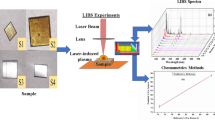Abstract
The present paper discusses about a new method developed for determining the quality of BWR and PHWR core components with respect to chemistry viz; determination of alloying elements as well as impurities using Radio Frequency Glow Discharge Optical Emission Spectrometer (RF GD-OES). Various experimental parameters of Glow discharge plasma such as forward power, Argon gas pressure inside plasma chamber, pre-integration time and integration time have been optimized using ‘‘Single parameter alternative method’’. The method has been validated using Certified Reference Materials (CRMs) and also by comparing with other techniques such as AAS and ICP-AES using statistical tests like F-test & t-test.








Similar content being viewed by others
References
Krishnan R, Asundi MK (1981) Zirconium alloys in nuclear technology. Engg Sci 4(1):41–56
Suri AK (2013) Material development for India’s nuclear power programme. Sadhana 38(5):859–895
Standard Specification for Zirconium and Zirconium alloy ingots for nuclear application, ASTM B 350.
Lemaignan C, and Motta A T (1994) Zirconium alloys in nuclear applications. Materials Science and Technology A comprehensive treatment, Cahn RW, Haasen P and Kramer EJ (eds). Springer: London. p 1
Sarathchandran N, Garg RK, Sundaram CV, Katiyar HC (1969) The present status and the projected programme of zirconium development in India. In: Symposium on non-ferrous metals technology, NML, Jamshedpur , 3: 1-10
Rama Rao GA (2005) Indian association of nuclear chemists and allied scientists (IANCAS). Nuclear materials, Vol IV 3:191–204
Nikulina AV, Malgin AG (2008) Impurities and their effect on the Structure and properties of zirconium parts in nuclear reactors. At Energy 105(5):328–339
Spitzer EJ, Smith DD (1952) Spectrochemical analysis of zirconium oxide. Appl Spectrosc. https://doi.org/10.1366/000370252774652424
Gordon NE, Jacobs RM Jr (1953) Spectrographic determination of impurities in zirconium and hafnium. Anal Chem. https://doi.org/10.1021/ac60083a008
Krishnan TS (1968) Analytical quality control in the production of nuclear grade zirconium and its alloys. Symposium on Non-ferrous Metals Technology, NML, Jamshedpur
Ma X, Li Y (2006) Determination of trace impurities in high-purity zirconium dioxide by inductively coupled plasma atomic emission spectrometry using microwave-assisted digestion and wavelet transform-based correction procedure. Anal Chim Acta 579(1):47–52
Martínez-Lebrusant Charo, Barba Flora (1990) Chemical analysis of impurities in zirconia and aluminium nitride ceramics by inductively coupled plasma atomic emission spectrometry. Analyst 115:1335–1338
Rosenberg R, Zilliacus R (1993) Determination of impurities in nuclear fuel element components by neutron activation analysis. J Radioannal Nucl Chem. https://doi.org/10.1007/bf02046789
Shinde AD, Acharya R, Reddy AVR (2017) Analysis of zirconium and nickel based alloys and zirconium oxides by relative and internal monostandard neutron activation analysis methods. Nucl Eng Technol 49(3):562–568
Farrell RF, Harter GJ, Jacobs RM (1959) Determination of trace inpurities in zirconium metal by point-to-plane spectrochemical procedure. Anal Chem 31(9):1550–1554
Iyer KV (2002) Techniques for chemical characterization of Zirconium and its alloys. Proceedings of the symposium, Zirconium-2002, BARC, Mumbai.
Adya VC, Arijit S, Godbole SV (2014) Study of the spectral interferences of zirconium on other analytes in the analysis of nuclear materials by CCD-based ICP-AES. Atomic Spectrosc 35:25–32
Menéndez A, Bordel N, Pereiro R, Sanz-Medel A (2005) Radiofrequency glow discharge-optical emission spectrometry for the analysis of metallurgical-grade silicon. J Anal At Spectrom 20:233–235
Harville TR, Kenneth Marcus R (1995) Determination of precious metal alloys by radio frequency glow discharge atomic emission spectroscopy. Anal Chem 67(7):1271–1277
Xhoffer C, Dillen H (2003) Application of glow discharge optical emission spectrometry in the steel industry. J Anal At Spectrom 18:576–583
Kenneth Marcus R, Broekaert JAC (2003) Glow discharge plasma in analytical spectroscopy. Wiley, West Sussex
Nelis T, Payling R, Barnett NW (2003) Glow discharge optical emission spectroscopy a practical guide. Royal Society of Chemistry, Cambridge
Gupta SNVMS, Nayak AK, Misra UB, Yarasi BR, Phani Babu C, Kalyana Krishnan G (2017) A simple and rapid method for determination of boron in fast breeder components. J Radioanal Nucl Chem 313(3):571–579
Douglas SA, Donald WM, James HF, Stanely CR (2014) Fundementals of analytical chemistry, Brooks/Cole, Cengage Learning, 9th ed
Author information
Authors and Affiliations
Corresponding author
Additional information
Publisher's Note
Springer Nature remains neutral with regard to jurisdictional claims in published maps and institutional affiliations.
Rights and permissions
Springer Nature or its licensor (e.g. a society or other partner) holds exclusive rights to this article under a publishing agreement with the author(s) or other rightsholder(s); author self-archiving of the accepted manuscript version of this article is solely governed by the terms of such publishing agreement and applicable law.
About this article
Cite this article
Rao, Y.B., Gupta, S.N.V.M.S., Kumar, P.V.N. et al. Development of RF GD-OES technique for chemical qualification of BWR and PHWR core components. J Radioanal Nucl Chem 333, 107–116 (2024). https://doi.org/10.1007/s10967-023-09194-8
Received:
Accepted:
Published:
Issue Date:
DOI: https://doi.org/10.1007/s10967-023-09194-8




